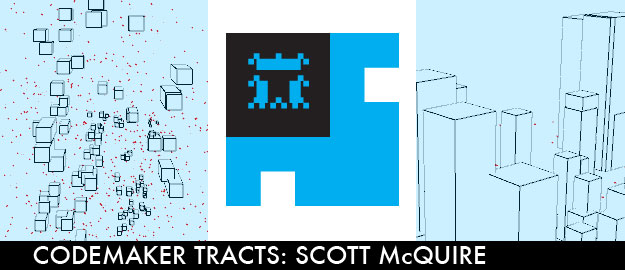Scott McQuire ::: University of Melbourne
Metaphors are important. More than mere descriptions, they shape our relation to particular objects and environments. Back in the 1850s, when Paris was still a largely medieval city choking on its fast growing population, the dominant metaphor for the city was the human body. Paris was a sick body with poor circulation in need of radical surgery; its Prefect, Baron von Haussmann, soon supplied the remedy, as his reforms cut the old city apart with modern razor-straight boulevards. Within two generations the dominant urban metaphor had shifted in accord with the new realities of industrial life. For modernists such as Corbusier, cities were machines whose individual parts needed to be assigned specific functions and calibrated through central planning to form a single, smoothly operating unit. Today cities are frequently described as ecologies. The new metaphor indicates that cities are now recognized as a type of habitat, a constructed nature. Further, that like natural ecologies, the eco-systems of cities are complex and open-ended, involving the dynamic interplay of diverse elements, including topography, architecture, technologies and people, in ways which cannot be easily unified.
No matter how big cities get, living in them has always depended on local knowledge. When I first visited Tokyo at the height of the ‘bubble economy’ in the late 1980s— a moment when the speculative land value of the city was roughly equal to that of the entire United States—I was struck by how much this centre of global capitalism was still in fact a collection of distinct villages. Many areas in central Tokyo didn’t have street numbers. You needed to know the apartment buildings by name to navigate. Similarly, as a student in the early 1980s, before the Nieuwenhuysen reforms liberalized Melbourne’s licensing laws beyond recognition, I soon learnt where I could get a beer or glass of wine after hours: upstairs at the Waiter’s Club, at Stalactites, or down the next laneway at Tsakpina where I learnt to play backgammon. This sort of knowledge was passed on by word of mouth, forming an unofficial map of the city.
Urban ecologies are composed of these informal networks of knowledge, as much as by more official networks such as Melbourne’s grid of streets. But the ecological parameters of contemporary cities have been substantially transformed over the last decade by the widespread deployment of digital networks. Access to digital platforms is becoming pervasive in many cities, and the old dream of ‘anytime, anywhere’ is approaching realization. Moreover, media are fast becoming geomedia, in which place specific data and location-aware devices are creating the conditions for new practices of networked urban communication. The word of mouth that took me down a particular laneway in the 1980s can now have greater persistence and extension in time and space. Informal knowledge provided by multiple networks of city-dwellers can made available as dynamic digital data tagged to specific sites. How might this change the dynamics of public space? Can the lessons of peer-to-peer networks, with their new modes of collaborative production, participation and exchange, be extrapolated into peer-to-peer urbanism?
All too frequently the potential of new technologies is watered down reduced to tired old formulas. The use of digital data for commerce or security has become so routine that it often obscures other possibilities. Intimacy is now a currency being tracked, measured and sold back to us via social networking services. This is why experimental uses of digital networks for art and activism remains vitally important—not only because it can be fun, but because it reminds us that we can imagine alternative settings.
Playing in the contemporary networked city is a curious business. In the 1950s, play was seen as a possible counter-balance to excessive rationalization of urban space. Urban games such as those famously devised by the Situationists in Paris sought to encourage people to step off their usual pathways and to look at familiar spaces differently with an eye to appropriating them outside their official uses. The sociologist Richard Sennett argued that game playing in the city had political importance, first because it drew attention to the accepted rules of social life, and, second, because it created a potential space for their experimental reconstruction.
Of course, play itself has changed in the 21st century. Digital gaming has become a mega-industry, part of the so-called military-entertainment complex. Companies such as Microsoft, which pioneered the contemporary blurring of work and play, have given birth to digital sweatshops all over the world. Many digital platforms now depend on user-generated content which is appropriated by the platform owner. In this context, we can’t assume that play is inherently liberating, any more than we can assume that the internet is going to automatically ‘democratise’ society. Instead of generalizing, we need to ask specific questions. In what circumstances does urban play encourage us to step outside our tele-cocoons, explore our surrounds, and communicate more openly with strangers? Can play become a means of breaking through the barriers of ambient fear that so often paralyse social encounters in the contemporary city?
Urban public space has always been contested space. Different interests overlap, different agendas have to be negotiated. In 1967 French sociologist Henri Lefebvre published his famous tract ‘Right to the city’ which challenged the top-down ethos of modern urban planning, and instead argued that the capacity for a city’s inhabitants to actively appropriate the time and space of their surroundings was a critical dimension of modern social democracy. What might this right to the city mean in the context of a networked city? A city in which informal local practices remain important, but the bounds of the local can no longer be assumed to form a closed domain. Today the local is constantly reworked by the possibility of global extension through digital annotation. This is the new, uneven space of the city that urban gaming needs to explore.
© Scott McQuire 2010.
